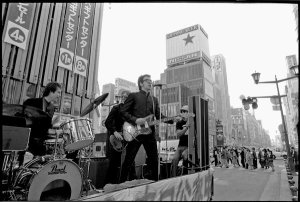Do you like the idea of hanging out with people in a laid-back environment where you have free WiFi, beer, and ping pong? Hell yes. Do you want to work in this environment? Hallelujah.
WeWork sounds like a cool co-working concept where users pay fees for differing levels of access and services. But when I saw that venture capitalists have valued the company at $5 billion, I needed a beer of my own to wash down this slice of fantasy.
Source: Bloomberg
Here’s the founder quoted in Bloomberg’s article:
Adam Neumann, WeWork’s Israeli-born co-founder, has called the company a “physical social network,” and it makes every effort to lubricate connections. “We gave 90,000 glasses of beer last month,” he said in a recent onstage interview at TechCrunch Disrupt NY 2015, “which is a number we’re proud of.”
I get the general concept, and it is appealing: there’s probably enough people in New York, LA, Chicago and San Francisco who would rather pay a la carte for office space. There’s a cool factor as well. These aren’t beige-carpeted Regus office centers with a Bunn coffee maker in the corner. Non-dairy creamer is probably disdained at WeWork.
But a $5 billion valuation is preposterous.
There are many flaws in the venture capitalists’ assumptions:
First, they make the old Pets.com argument that X is a multi-billion dollar market, and if we can just capture Y, we’ve got a home run. In this case, they estimate the size of the office market as being $15 trillion, so their whole value is based on the idea that they can capture just a thimble-full of the market. Unfortunately, capturing a market of users does not necessarily translate into profits.
The doubts pile up quickly:
A. Sorry, there’s just not that many freelancers. I know we’ve all seen the hype around start ups, but most new tech businesses generate zero cash flow for many months or years and are purely boot strap operations that can’t stomach a posh rent in a highrise office space. There’s a reason why a lot of Silicon Valley success stories got started in garages.
B. So where do most small companies and freelancers work?Their homes. Why pay double rent?
C. Open floor plans suck if you need to complete tasks that require focused concentration. I’ve tried it. It’s hell.
D. There are already competitors (and will be more)…including building owners themselves.
E. There’s a little place called Starbucks that has free WiFi. I’ve heard they have some locations around.
F. WeWork has no assets and relies entirely on leased space. Leases are a contractual obligation akin to debt. They may not get capitalized on a balance sheet, but they should be. The company will immediately be an over-leveraged behemoth with tremendous fixed costs.
G. Ping pong and beer are amenities, they’re also distractions for the others who actually need to work. Go to a bar.
H. They will need to hire a staff to maintain the spaces.
Here’s my biggest gripe: The article references Uber as a comparable. The logic goes something like this: workers share spaces and more efficiently utilize a common area by making use of what would otherwise be spare capacity. But is WeWork really like Uber? In the case of Uber, individual drivers carry all the risk and Uber only acts as a technology infrastructure for sharing transportation. If there is no one to pick up, its the driver who doesn’t make any money. In this model, WeWork carries all the risk.
If I was going to create an “Office Uber” I can see a better market where companies with existing leased office space (an advertising firm or insurance company) post available cubes and conference rooms for rent when they are empty. You probably have offices that only run at 50-75% capacity on a daily basis (ie, Don Draper heads to California for a few weeks), so there’s a lot of spare space that can be posted. I’m sure someone has already thought of this concept.
On the positive side for WeWork, there’s probably a health club model here – sign up tons of people at $40 per month and know that they only show up a fraction of the time of what they thought.
But $5 billion is a bridge too far.
Kilroy Property Trust is one of the biggest office landlords in San Francisco (if not in the the entire US) and their market cap is $6 billion. Ping Pong and beer are probably not included in Kilroy’s market capitalization, however, so there’s tons of upside.

 There’s never going to be a formula that will make you rich just by going through some little process. If that were true, every mathematical nerd that gets A’s in algebra would be rich.
There’s never going to be a formula that will make you rich just by going through some little process. If that were true, every mathematical nerd that gets A’s in algebra would be rich.





